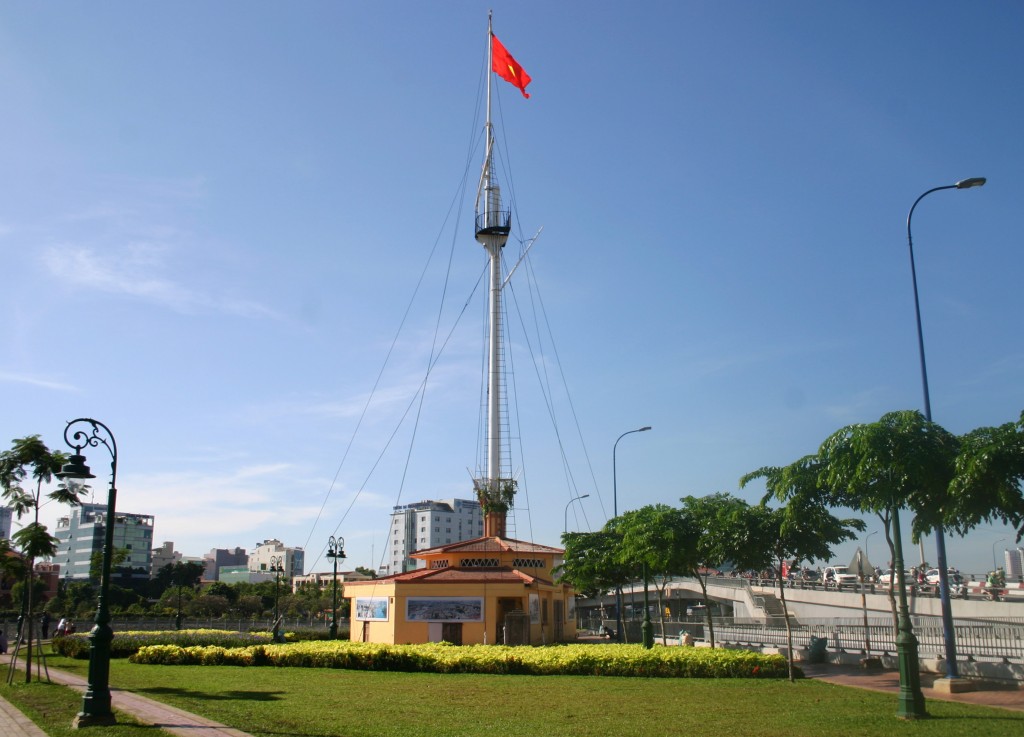
The Signal Mast today
This article was published previously in Saigoneer http://saigoneer.com
A time-honoured landmark on the Saigon riverfront, the Signal Mast (mât des signaux in French, Cột cờ thủ ngữ in Vietnamese) was recently refurbished as the centrepiece of the Saigon riverside park.
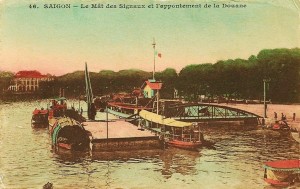
A “colorised” image of the mât des signaux in the late 19th century
In his 1869 book Cochinchine française et royaume de Cambodge, Charles Lemire tells us that the headland where the Saigon river met the Arroyo Chinois (Bến Nghé creek) was originally known as pointe Lejeune, after Captain (later Rear Admiral) Laurent-Joseph Lejeune (1817-1895), Commander in chief of the French Navy in Cochinchina during the 1860s. Lejeune built many of Saigon’s port facilities and is credited with the construction of the original Signal Mast, which opened in October 1865.
Originally a simple flagpole, its main function was to communicate with vessels on the river using signal flags, but according to Lemire, it was also avidly watched by the city’s colonial population, to whom it “signalled the impending arrival of war, commerce and mail ships, which had been announced by telegraph from cap Saint-Jacques [Vũng Tàu].”
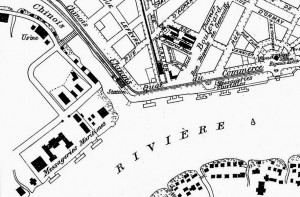
This 1896 city map shows the route of the “Low Road” steam tramway past the mât des signaux
However, from an early date the Signal Mast also became a popular recreational spot for colonial settlers. Lemire remarked that at 5pm every Monday and Friday, the entire beau monde of Saigon would come here to listen to music performances by military bands.
In 1891, the Signal Mast became the first stop on the new “Low Road” steam tramway, which ran from place Rigault de Genouilly [Mê Linh square] in Saigon to the confluence of the Saigon river and the arroyo Chinois, before taking the north bank of the arroyo all the way to Chợ Lớn. The tramway line ran past the Signal Mast until the mid 1920s, when it was electrified and rerouted through the city centre.
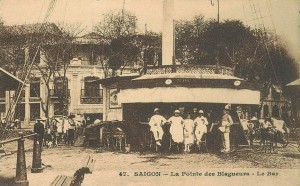
A bar was opened at the mât des signaux during the 1920s
By 1894, the flagpole needed replacement and in that year authorisation was given to proceed with the construction of a new one, complete with an office/storage facility and a floating dock. However, for budgetary and administrative reasons, this work was not completed until 1900.
By that time, the headland next to the Signal Mast had acquired the popular name Pointe des blagueurs (“Jokers’ Point”) and in the evenings many French expatriates would come here after dinner to watch the boats go by. From the 1920s onwards, the building at the foot of the flagpole was rented out to local entrepreneurs, who ran it as a bar.
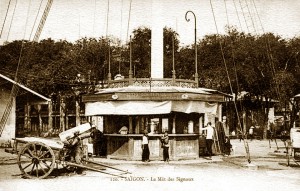
Another view of the bar which opened at the mât des signaux during the 1920s
By the 1940s the Signal Mast had become home to the famous “Restaurant de la Pointe des Blagueurs,” run by Madame Durand.
However, according to the plaque on the wall outside, the Signal Mast is best remembered locally for a fierce battle which took place here on 23 September 1945 between resistance forces armed with makeshift weapons and British Indian troops, who at that time were facilitating the return of the French.
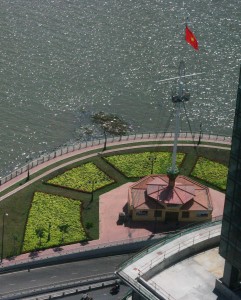
The Signal Mast today viewed from above
In 2010, as part of the landscaping of the quayside, the Signal Mast was refurbished and signs appeared outside announcing that it was to open as an exhibition centre. This plan seems to have since been shelved and the building has been closed ever since.
However, since its regeneration, the headland park has become one of the most pleasant outdoor spaces in the city, enjoyed by an ever-increasing number of visitors and locals. Perhaps we should expect a 20th century version of the former Restaurant de la Pointe des Blagueurs to be opened in the old Signal Mast in the near future….
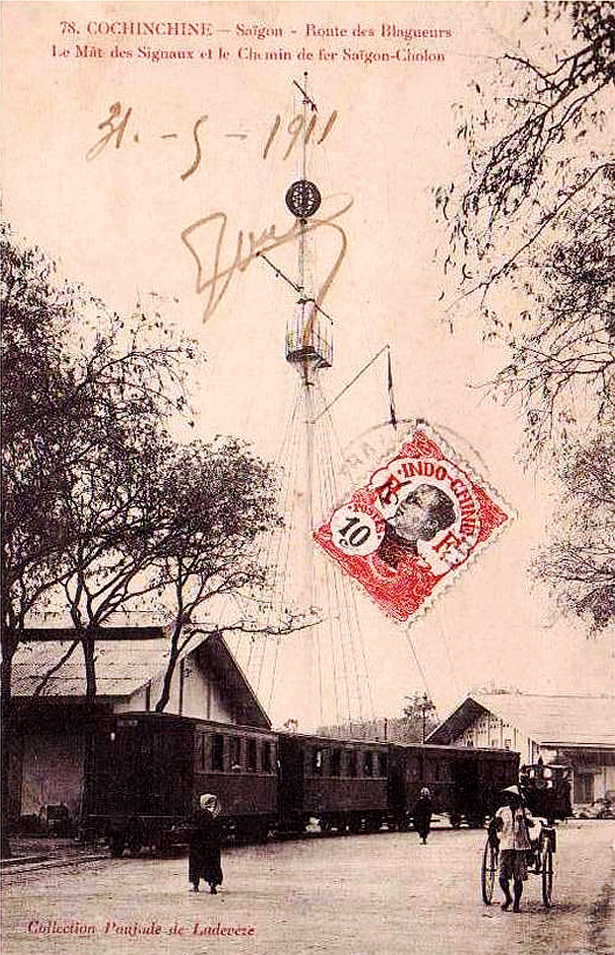
After 1891, “Low Road” tramway services from Saigon to Chợ Lớn stopped at the mât des signaux
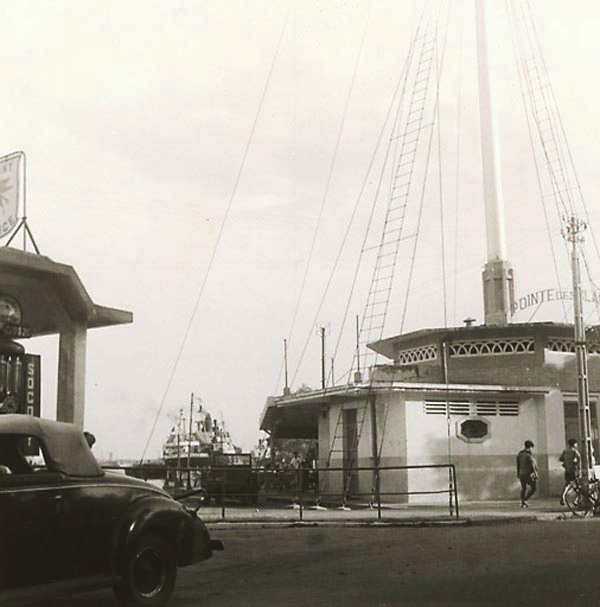
The Signal Mast in the 1950s
Tim Doling is the author of the guidebook Exploring Saigon-Chợ Lớn – Vanishing heritage of Hồ Chí Minh City (Nhà Xuất Bản Thế Giới, Hà Nội, 2019)
A full index of all Tim’s blog articles since November 2013 is now available here.
Join the Facebook group pages Saigon-Chợ Lớn Then & Now to see historic photographs juxtaposed with new ones taken in the same locations, and Đài Quan sát Di sản Sài Gòn – Saigon Heritage Observatory for up-to-date information on conservation issues in Saigon and Chợ Lớn.

